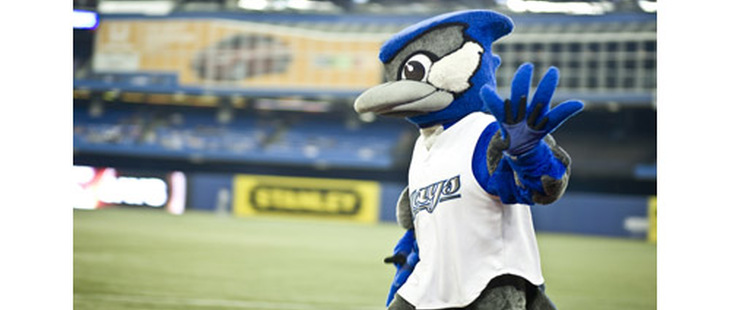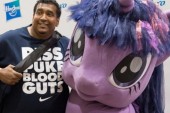

We’ve thought it over
Having generated some hope and excitement back in 2010 for 2011, no longer saddled with disappointments from previous seasons, and not handcuffed to a contract and personnel structure guaranteed to keep the team in mediocrity, our Toronto Blue Jays have seized the opportunity that is the 2011 season to generate some hope and excitement for 2012. That’s not a bad thing at all (it’s not necessarily even an accurate thing because there’s no telling what the Jays are going to put together as an end of the season stretch, but we’re not the Giants right now). You can’t build a crop of young and exciting talent in just one season. And that’s exactly what these Baby Jays are shaping up as, a crop of young and exciting talent (and I’m busily preparing notes on all of the reasons, from players all the way through to management, to start watching this team with close attention as of now, to be shared soon).
Whenever you’re not in a position to win right now, young, potential-filled players are always welcome. But because you’re not winning in the meantime, it’s imperative to be in a position to start doing some winning when your young talent is good and ready to mature. It works out best when, just as your ‘once promising stars-of-tomorrow’ become ‘ready to win right now stars-of-today,’ that you’re a ‘ready to win right now’ kind of team. One of the ways to try and achieve this sort of synchronicity is to do what the Jays are trying to do, which is to field a team on which 24-year-old Colby Rasmus isn’t out of place. And then maybe we’ll get to see the team we’ve got become a championship team right in front of our eyes.
But it’s risky strategy anytime the volatility of youth is in the mix. I mean really, there’s risk in any long range strategy in sports because you can’t ever predict what’s going to happen, you can’t build a sure thing. But with young players there are even more unpredictable factors. Maybe an intriguing prospect never really materializes as major talent as expected. Maybe the pieces grow apart as they grow up, and an uncertain identity or even pecking order of the team leads to a decent into a clash of egos, a battle of whose team this really is or is going to be. And of course another factor, although probably tied in with ego, is money. If a young team grows up into prominence together, then a successful formula would dictate that as the players get better, the team gets better. But this also means that as the team gets better, the players see that they’re getting better. And it’s also true probably that other (interested) teams are seeing the players get better, and their overall market value can take a pretty big climb. Now all of the sudden your team, if contracts happen to come up for renewal at the same time, can cost too much to keep together. And there’s no predicting how money, especially as it either does or doesn’t stack up to how much everyone else is getting, gets in the way of keeping a good thing going (or a good team together).
And we want less money
But what can really happen? Sports and money, it’s an institute you can’t disparage. There might not really be anything wrong that either. It seems about as American as, well, most of the major sports we watch. And while Hope Solo seems to be leading the way in the media parade after the U.S. team placed second at the FIFA Women’s World Championships, strongly branding herself and gathering up endorsements, an intriguing story has emerged this week from another alcove of American sport. From the, until recently, locked out world of the NFL, we welcome back to the limelight Peyton Manning.
But not really to the limelight, or at least not the brightest of limelights. Peyton recently, while in negotiations with Indiana Colts management for his new contract, possibly his last ever, told his team that he doesn’t want to be the highest paid player in the league (although they had stated already that they were ready to make him just that). Instead, Peyton asked simply to be paid what Tom Brady is getting from his New England Patriots (Manning and Brady are both elite quarterbacks in the league). Maybe he chose not to break the Colts’ bank because he wanted them to go out and sign him some players he could win another Super Bowl with. Maybe he didn’t want the hassle of being targeted as the most money-hungry player in the NFL. I know there’s nothing really altruistic about this, and of that of course Peyton Manning is still getting paid an unbelievable amount of money. But if you look at it as purposeful gesture, to say: I don’t want to be the highest paid player in the league, it can be read as saying: it is not the absolute measure of my talents and worth to be paid the absolute most. It means there must be something else to play for, which is nice.
Coming up in the next couple of months, I predict we’re going to be hearing a lot about Tiger Woods as he finally starts golfing again, Serena Williams further along on her comeback trail, and hopefully our Toronto Blue Jays. Imagine if we could just instill this idea with them all, as a kind of mantra. Rick Reilly recently detailed what he called ‘the new normal’ for Tiger, which is mostly a list of how to modify his behaviour now that he’s not automatically dominant on the course and has undergone numerous public problems. It can sort of be summed up by adopting the attitude that he doesn’t want to go out there and be the highest paid golfer he can dream of being. But he can just go out there and golf. When Serena Williams is up at York University this month, maybe she can worry less about her rankings, about thinking nobody can ever beat her but herself, and just compete with the best players in the world.
And when the players for the Jays all want their new contracts, if they’ve got something to gain from any new found team success, maybe they can look around and think (or even say), I don’t want to be the highest paid player on this team. But still want to be on the team. It could be a commercial even for the spirit of the new Jays. I mean, I know that commercial couldn’t, maybe even shouldn’t exist. But it might work better for the U.S. women’s soccer team. You don’t get paid for playing on a national team anyway, so it would add a whole new dimension to it all. Hope Solo, looking at all of her national teammates and saying: I don’t want to be the highest paid player on this team. This is a marketing idea I’ll gladly offer to anyone.














